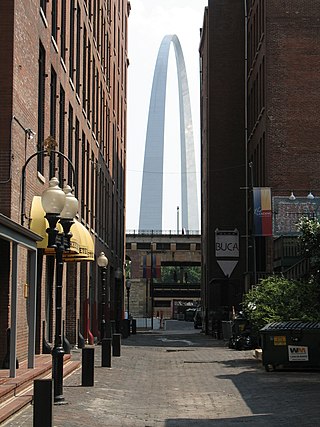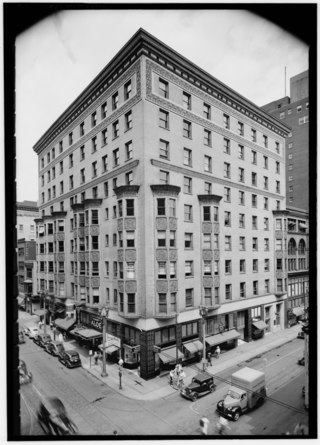
The French Quarter, also known as the Vieux Carré, is the oldest neighborhood in the city of New Orleans. After New Orleans was founded in 1718 by Jean-Baptiste Le Moyne de Bienville, the city developed around the Vieux Carré, a central square. The district is more commonly called the French Quarter today, or simply "The Quarter", related to changes in the city with American immigration after the 1803 Louisiana Purchase. Most of the extant historic buildings were constructed either in the late 18th century, during the city's period of Spanish rule, or were built during the first half of the 19th century, after U.S. purchase and statehood.

The Old Brick Capitol in Washington, D.C., served as the temporary meeting place of the Congress of the United States from 1815 to 1819, while the Capitol Building was rebuilt after the burning of Washington.

Laclede's Landing, colloquially "the Landing", is a small urban historic district in St. Louis, Missouri. It marks the northern part of the original settlement founded by the Frenchman Pierre Laclède, whose landing on the riverside the placename commemorates. Originally he tasked his 14-year-old stepson, Auguste Chouteau, with the task of preparing the land that sat 10 miles south of the Mississippi-Missouri area. A stone house was erected and named Laclede's home in the village he named "St. Louis" as a homage to King Louis IX of France. Initially, fur trade and trapping was the economic interest that would spark Pierre's interest in using the landing and making his stepson the richest citizen. The area is now decorated with 19th century warehouses and other period buildings.

The St. Louis Arsenal is a large complex of federal military weapons and ammunition storage buildings operated by the United States Air Force in St. Louis, Missouri. During the American Civil War, the St. Louis arsenal's contents were transferred to Illinois by Union Captain Nathaniel Lyon, an act that helped fuel tension between secessionists and those citizens loyal to the Federal government.

Old North St. Louis is a neighborhood just north and slightly west of the downtown area of St. Louis, Missouri. It is known for Crown Candy Kitchen, historic 19th-century brick homes, and its community gardens.

Downtown St. Louis is the central business district of St. Louis, Missouri, the hub of tourism and entertainment, and the anchor of the St. Louis metropolitan area. The downtown is bounded by Cole Street to the north, the river front to the east, Chouteau Avenue to the south, and Tucker Boulevard to the west. The downtown is the site of many corporate headquarters, including Stifel Financial Corp., HOK, Spire Inc, and a host of other companies.

LaSalle Park is an integral part of the three-neighborhood "Old Frenchtown" area—LaSalle Park, Lafayette Square and Soulard—bordering the southern edge of downtown St. Louis. It was formed as a "new" neighborhood, legally distinct from the larger Soulard district, through the efforts of the city of St. Louis, Missouri and Ralston Purina, which has its world headquarters in LaSalle Park.

The St. Louis Mercantile Library, founded in 1846 in downtown St. Louis, Missouri, was originally established as a membership library, and is the oldest extant library west of the Mississippi River. Since 1998 the library has been housed at the University of Missouri-St. Louis as a Special Collections library within the Thomas Jefferson Library. The majority of library materials can be assigned to one of four categories: the General (Core) Collection, the John W. Barriger Railroad Library, the Herman T. Pott National Inland Waterways Library, or the Art Museum. The collections of the St. Louis Mercantile Library have been named a City Landmark by the city of St. Louis, Mo., due to the cultural significance of the library.

Tiffany is a neighborhood of St. Louis, Missouri. It is located on the western side of Grand Boulevard along the section containing St. Louis University's Medical Complex. The neighborhood is defined by Chouteau Avenue on the North, Interstate 44 on the South, Grand Boulevard on the East, and 39th Street on the West.

Tower Grove South is a neighborhood of south St. Louis, Missouri. Formerly known as Oak Hill, Tower Grove South is bounded by Arsenal Street on the north, Chippewa Street on the south, Kingshighway Boulevard on the west, and Grand Boulevard on the east. The majority of the neighborhood was built following the extension of streetcar lines from downtown St. Louis. Commercial development in the neighborhood is concentrated on Grand Boulevard in the east and Morganford Road in the west of the neighborhood. There are also scatterings of commercial and mixed use buildings on interior intersections.

The Galena Historic District is a historic district located in the city of Galena, Illinois, United States. The historic district encompasses 85 percent of the city of Galena and includes more than 800 properties. The downtown area consists of three successive tiers made up of Main, Bench and Prospect Streets. Within the boundaries of the district are such notable homes as the Ulysses S. Grant Home and the Elihu B. Washburne House. The Galena Historic District was added to the U.S. National Register of Historic Places in 1969.

The Peacock Alley was a jazz club at 2935 Lawton Boulevard St. Louis, Missouri. It was one of St. Louis' most important nightclubs in the 1950s. Due to its close proximity to Union Station, it was favored among musicians.
Main Street is a major north–south thoroughfare in Los Angeles, California. It serves as the east–west postal divider for the city and the county as well.

Barnett, Haynes & Barnett was a prominent architectural firm based in St. Louis, Missouri. Their credits include many familiar St. Louis landmarks, especially a number related to the local Catholic church. Their best-known building is probably the Cathedral Basilica of St. Louis. A number of the firm's works are listed on the U.S. National Register of Historic Places.

The Planter's House Hotel was the name of three hotels in St. Louis, Missouri. The first operated from 1817, the second from 1841 to 1891, and the third until 1922.

The Southern Hotel was a historic hotel located at the corner of 4th Street and Walnut Street and stretching between 4th and 5th Streets in St. Louis, Missouri. The building was built at the location of the Old Southern Hotel which burned in 1877. This 1877 hotel fire and the loss of life that occurred here made this the worst hotel disaster in St. Louis history. The new Southern Hotel had white marble, extensive fresco work, a rotunda, and a wide promenade. The hotel was owned by Robert G. Campbell who had a close friendship with President Grant.

Barnum's St. Louis Hotel was a historic 6-floor hotel built in 1854. The Barnums were a family of hotel keepers who had run the famous Barnum's Hotel in Baltimore. This building was located at the 2nd and Walnut Streets in St. Louis, Missouri, and has been considered to be St. Louis' first high-rise building. The hotel was designed by architect George I. Barnett.

The St. Nicholas Hotel was a historic hotel located at the northwest corner of 8th Street and Locust Streets in St. Louis, Missouri. After the hotel was closed in 1905, it was turned into an office building and renamed the Victoria Building. The original St. Nicholas Hotel in St. Louis was located on 4th Street, but this building was destroyed by a fire in 1884. The fire was not a hotel fire as the building was only occupied by stores at the time. This January 4, 1884, fire is remembered as one of the most difficult for the St. Louis Fire Department as the temperature had fallen to 26 degrees below zero with ice reaching two-feet thick to the outside walls after water had been sprayed on the exterior.

St. Louis City Hall was designed by architects Eckel & Mann, the winners of a national competition. Construction began in 1891 and completed in 1898. Its profile and stylistic characteristics evoke the French Renaissance Hôtel de Ville, Paris, with an elaborate interior decorated with marble and gold trim.

The National Hotel was a hotel in Washington, D.C. It was located on the northeastern corner of the intersection of Pennsylvania Avenue and 6th Street NW. John Gadsby had it built in 1826. The hotel was sold to the city in 1929, and it was demolished in 1942.



















